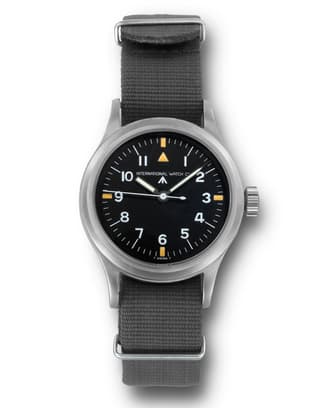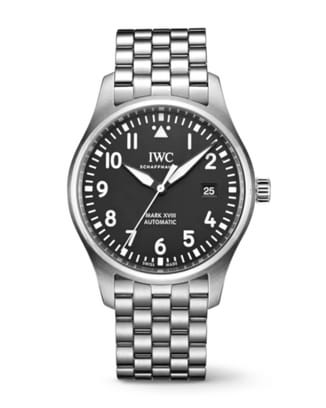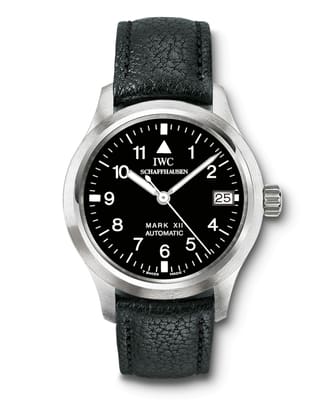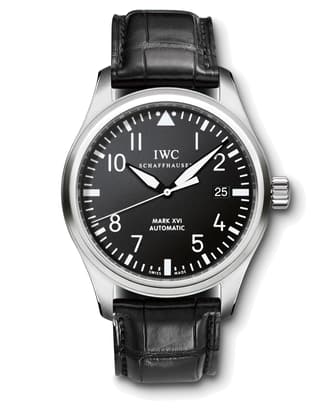World of watches
THE IWC MARK XVIII: THE EVOLUTION OF A LEGEND
THE IWC MARK XVII STANDS ON THE SHOULDERS OF A GIANT, THE MARK 11. MICHAEL FRIEDBERG ANALYZES HOW THIS ICONIC TIMEPIECE BRIDGES PAST AND PRESENT.
By Michael Friedberg

The IWC Pilot’s Watch Mark XVIII (IW327015) is a tool watch and the heir to IWC’s iconic Mark 11. The Mark 11 was IWC’s first megastar, but from modest origins. Starting in 1948, the watch was supplied to the British Ministry of Defense pursuant to a military supply contact. Intended as a highly accurate, anti-magnetic instrument for astro-navigation, the Mark 11 was primarily issued to Royal Air Force navigators and later to pilots.
The Mark 11 evolved into a legend, evoking the romance of flying and the significance of history. In turn, pilot’s watches developed into an entire genre of the Swiss watch industry. They represent the antithesis of a jewelry watch, with their plain black dials and stark white Arabic numerals. These watches were intended to legibly and accurately show time while surviving the rigors of military deployment.
A WATCH MAKES ITS “MARK”
IWC has been a clear leader in the development of pilot’s watches. In 1994, the company paid homage to its Mark 11 with a Mark XII (3241) model. That civilian watch was based on the design of the Mark 11 but with a modern automatic movement and a date function. The name “Mark XII” was borrowed from its military predecessor. To underline the difference between the historical watch and the new collection, IWC used Roman numerals for this model instead of Arabic.
The IWC Mark XII was succeeded by several other IWC pilot’s watches, all designated with the “Mark” name. Since 13 and 14 are unlucky numbers in some cultures, IWC in 1999 introduced a Mark XV model (IW325301), followed by the Mark XVI (IW325501) in 2006 and then the Mark XVII (IW326501) in 2012. These all were time-and-date only pilot’s watches and all shared a family resemblance.
Given this strong heritage, in 2016 the Mark XVIII had a daunting role to assume. It is never easy following an icon, let alone a whole generation of emblematic pilot’s watches.
UPDATING AN ICON
The first Mark XVIII model from 2016, IWC reference IW327001, set the standard. Available only in steel, like a true tool watch, the watch was time-and-date only and 40mm in diameter. Importantly, like the original Mark 11 and other watches intended for flight use, it was anti-magnetic. A soft-iron inner case encapsulated the movement and its sapphire glass was secured against drops in pressure.
That model initially was produced in several variations, including with a white dial (IW327002) and with steel bracelets. Two special models also were produced in 2016, including a blue dial Le Petit Prince (IW327004) and a 41mm ceramic/titanium Pilot’s Watch Mark XVIII Top Gun Miramar version (IW324702).
After seven references in 2016, the popularity of the Mark XVIII resulted in four additional models in 2017 and more in 2018. Some are rare special editions, such as one only available to active-duty graduates of the US Navy Fighter Weapons School, also known as “Top Gun”.

NEW MODELS AND A NEW MOVEMENT
Two models from 2017 are especially popular. One is the titanium Pilot’s Watch Mark XVIII Heritage Watch (IW327006), and the other is 1948-piece limited edition Pilot’s Watch Mark XVIII Edition “Tribute to Mark XI” (IW327007). The Tribute also looks remarkably like the original Mark XI, with its dial and hands paying homage to the original icon. But it also makes its historic ancestor into a contemporary timepiece.
The Tribute of course is anti-magnetic and now is water resistant to 6 bar. It has a durable automatic movement (IWC calibre 35111) with date. The case is a modern 40mm in diameter. It now sports a nylon “NATO-style” strap. This new model cleverly, and subtlely, goes far beyond replicating a prior design. Looking very much like its revered predecessor, it now is a thoroughly modern watch.
The basic Mark XVII, though, remains the cornerstone of the collection. In 2018, new reference numbers were assigned since those models now use a new movement, the aforementioned IWC calibre 35111. A 1,500-piece limited edition also was produced this year for the Laureus Sport for Good Foundation. New straps were also introduced.
Despite numerous references and variations, the essence of the Mark XVIII remains the same. It is a simple watch, durable, accurate and to be used as a tool. It evokes what military pilots wore in the 1940s and ‘50s and reminds us of IWC’s renowned pilot’s watch legacy.
The Mark XVIII watch, in all models, succeeds as a triumph of everything old and everything new in one timepiece. It follows a fine legacy as the essence of its genre.
Michael Friedberg has been collecting watches, especially IWCs, for more than three decades. From 2001 through 2015 he was moderator of the IWC Collectors’ Forum and has written extensively about IWC’s history and technical features.








